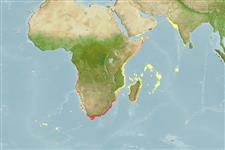Lớp phụ Cá sụn (cá mập và cá đuối) (sharks and rays) >
Myliobatiformes (Stingrays) >
Gymnuridae (Butterfly rays)
Etymology: Gymnura: Greek, gymnos = naked + Greek, oura = tail (Ref. 45335).
More on authors: Gilchrist & Thompson.
Environment: milieu / climate zone / depth range / distribution range
Sinh thái học
Biển gần đáy; Mức độ sâu 20 - 100 m (Ref. 28016). Subtropical
Southeast Atlantic and Western Indian Ocean: Namibia round the Cape to southern Mozambique.
Length at first maturity / Bộ gần gũi / Khối lượng (Trọng lượng) / Age
Maturity: Lm ?, range 150 - ? cm
Max length : 250 cm WD con đực/không giới tính; (Ref. 3263); Khối lượng cực đại được công bố: 82.6 kg (Ref. 40637)
Các tia vây lưng cứng (tổng cộng): 0; Các vây lưng mềm (tổng cộng): 0. Broad diamond-shaped pectoral disc almost twice as wide as it is long; tail shorter than body with black and white bands and a small sting; tentacle at rear edge of each spiracle (Ref. 5578). Grey, green or brown above, often with darker mottling; white below; can change color of upper disc rapidly to match substrate (Ref. 5578).
Occurs off sandy beaches, muddy estuaries and offshore banks. Found singly or in large groups (Ref. 5578). Feeds on a variety of fishes, crabs and polychaete worms (Ref. 5578). Ovoviviparous (Ref. 50449). Ability to change markings and color to blend into environment (Ref. 3263). Caught by offshore trawlers (Ref. 5578). Caught by shore anglers, it is prized for its strong fight when hooked, often released (Ref. 5578).
Exhibit ovoviparity (aplacental viviparity), with embryos feeding initially on yolk, then receiving additional nourishment from the mother by indirect absorption of uterine fluid enriched with mucus, fat or protein through specialised structures (Ref. 50449). Distinct pairing with embrace (Ref. 205). One year gestation; up to 10 young (Ref. 5578).
Compagno, L.J.V., 1986. Dasyatidae. p. 135-142. In M.M. Smith and P.C. Heemstra (eds.) Smiths' sea fishes. Springer-Verlag, Berlin. (Ref. 3263)
IUCN Red List Status (Ref. 130435)
Threat to humans
Harmless
Human uses
cá để chơi: đúng
Thêm thông tin
Các tài liệu tham khảoNuôi trồng thủy sảnTổng quan nuôi trồng thủy sảnCác giốngDi truyềnElectrophoresesDi sảnCác bệnhChế biếnNutrientsMass conversion
Các công cụ
Special reports
Download XML
Các nguồn internet
Estimates based on models
Preferred temperature (Ref.
123201): 14.5 - 27.1, mean 25.3 °C (based on 72 cells).
Phylogenetic diversity index (Ref.
82804): PD
50 = 0.5000 [Uniqueness, from 0.5 = low to 2.0 = high].
Bayesian length-weight: a=0.00776 (0.00352 - 0.01710), b=3.09 (2.89 - 3.29), in cm total length, based on LWR estimates for this (Sub)family-body shape (Ref.
93245).
Mức dinh dưỡng (Ref.
69278): 3.9 ±0.65 se; based on food items.
Thích nghi nhanh (Ref.
120179): Rất thấp, thời gian nhân đôi của chủng quần tối thiểu là hơn 14 năm (Fec=10).
Fishing Vulnerability (Ref.
59153): Moderate to high vulnerability (51 of 100).
